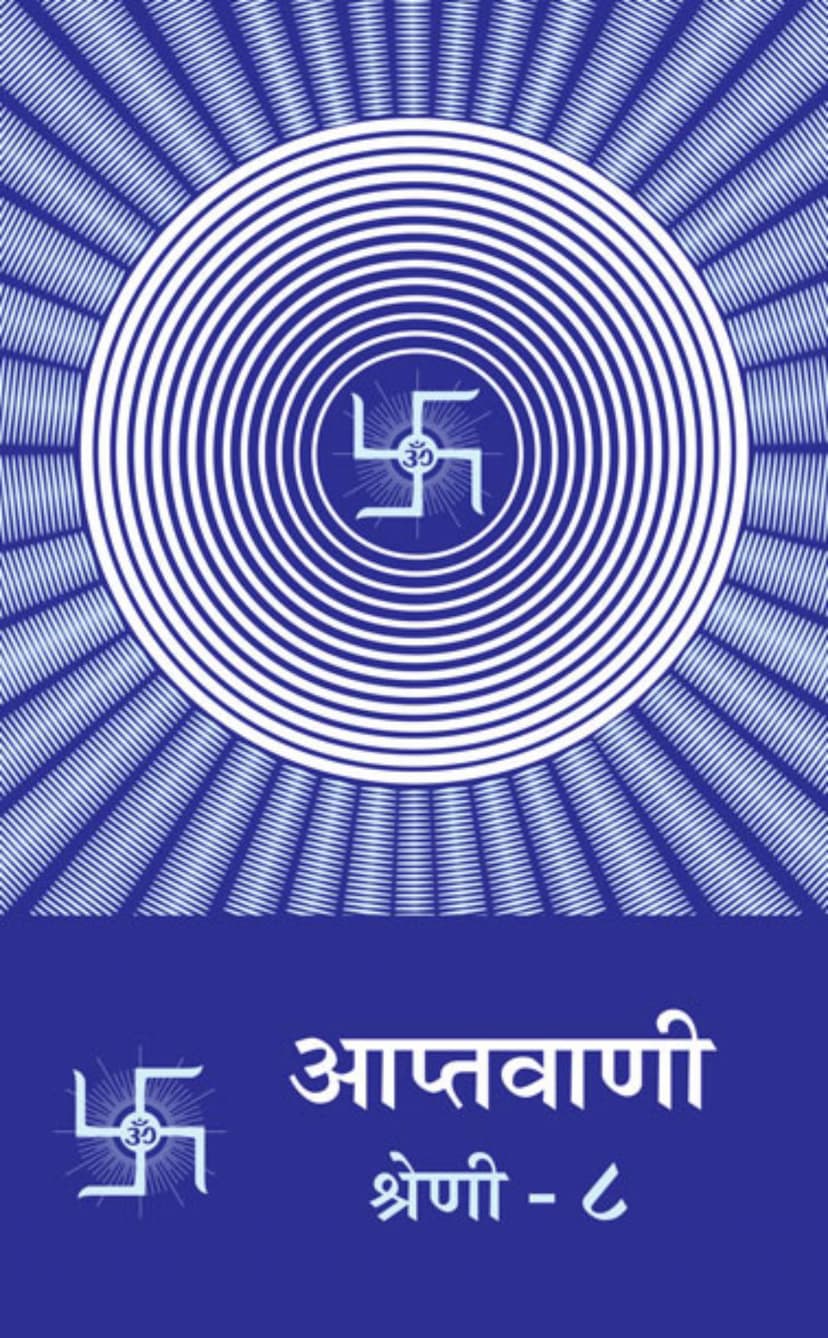Aptavani Shreni 08
Added to library: September 1, 2025

Summary
Here's a comprehensive summary of the Jain text "Aptavani Shreni 08" by Dada Bhagwan, based on the provided pages:
Title: Aptavani Shreni 08 Author: Dada Bhagwan (Param Pujya Dadashri) Publisher: Dada Bhagwan Aradhana Trust (Mahaavideh Foundation)
This book is the eighth volume in the "Aptavani Shreni" (Series of Discourses of the Self-Realized Soul) and contains spiritual discourses by Dada Bhagwan, who manifested in the physical body of Shri Ambalal Muljibhai Patel. The core message revolves around understanding the true nature of the self (Soul) and achieving liberation.
Key Themes and Concepts:
-
The Nature of the Self (Atma):
- The Soul is the true Self, distinct from the physical body, mind, and ego.
- The Soul is described as pure consciousness (chetan), light-form, infinite in knowledge, vision, power, and bliss.
- It is eternal, unborn, and immortal, untouched by the physical world.
- The Soul is not the doer (akarta) or the enjoyer (bhokta); these are functions of the ego and the phenomenal self.
- The Soul is inherently pure and free, but is currently veiled by ignorance and wrong beliefs.
-
Ignorance and Wrong Beliefs (Mithya Darshan/Bhranti):
- The primary cause of suffering and bondage is wrong belief – the identification of the self with the physical body, ego, and worldly relations ("I am Chandubhai," "I am the husband," "I am the father").
- These wrong beliefs create an illusion of doership and ownership, leading to the cycle of birth and death (samsara).
- The world itself is an interplay of 'real' (Atma) and 'relative' (body, mind, ego, worldly phenomena). The mistake is identifying the 'relative' as 'real'.
-
The Akram Path (Non-Linear Path):
- The book emphasizes Dada Bhagwan's unique "Akram Marg" (non-linear path) of Self-Realization. Unlike gradual spiritual paths (kramik), this is presented as a direct and swift method, like an elevator ride.
- This path involves receiving "Gnan" (Self-knowledge) from a living Gnani Purush (Self-Realized Master), which directly separates the Soul from the non-self.
-
The Gnani Purush (Self-Realized Master):
- Dada Bhagwan (Shri A.M. Patel) is presented as the Gnani Purush of this era.
- The Gnani Purush is the only one who can directly impart Self-knowledge and break the wrong beliefs that bind the soul.
- His discourses reveal the true nature of the Soul and the universe as it is.
- The discourses highlight the Gnani's complete detachment from the body and ego, living as the pure Soul.
-
Key Concepts Explained:
- Dravya, Guna, Paryay: The fundamental Jain principles of substance, attributes, and modes are discussed in relation to the Soul and the material world.
- Karma: The law of karma is explained, emphasizing that actions driven by ego and ignorance lead to bondage, while actions performed without ego, as a witness, do not create new karma.
- Reincarnation: The cycle of birth and death is explained as a consequence of karma and wrong beliefs, with the Soul transmigrating through various life forms.
- Moksha (Liberation): Moksha is described as the state of realizing one's true nature as the pure Soul, free from all worldly attachments, ego, and the cycle of birth and death. It is a state of eternal bliss and self-resplendence.
- Maya and Bhranti: The illusory nature of the world and the power of wrong beliefs in veiling the true Self are extensively discussed.
- Brahma, Ishwar, Paramatma: The text clarifies the hierarchical and functional differences between these concepts, ultimately pointing to the Soul as the true eternal reality.
- The Six Elements (Dravyas): The Jain concept of six eternal substances that form the universe is touched upon.
- The Nature of the World: The world is explained as a dynamic interplay of cause and effect (scientific circumstantial evidence), not created by a God in the traditional sense, but functioning through natural laws.
-
The Practical Application:
- The book encourages the reader to ask questions and seek direct understanding from the Gnani Purush.
- It emphasizes the importance of 'Self-Realization' (Atma-gnan) over mere intellectual knowledge or theoretical understanding of scriptures.
- The teachings aim to dismantle the reader's ingrained wrong beliefs and replace them with the 'Right Belief' of being the pure Soul.
Structure of the Book:
The book is divided into two sections:
- Khand 1: आत्मा क्या होगा? कैसा होगा? (What will the Soul be? What will it be like?) This section primarily addresses questions about the existence, nature, attributes, and location of the Soul, dispelling misconceptions.
- Khand 2: 'मैं कौन हूँ?' जानें किस तरह? (Who am I? How to know?) This section focuses on the practical aspect of realizing the Self, the difference between the Soul and the ego, and the path to liberation.
Overall Message:
"Aptavani Shreni 08" serves as a guide to understanding and realizing the Soul through the practical teachings of Dada Bhagwan. It aims to dismantle the illusion of the ego and worldly attachments, leading the reader towards the direct experience of their true, eternal, and blissful Self. The book stresses that mere intellectual understanding is insufficient; direct experience through the grace of the Gnani Purush is essential for liberation.